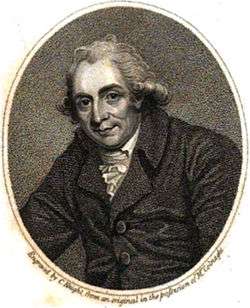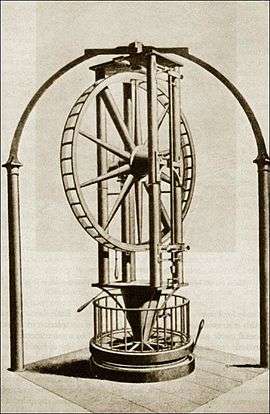Jesse Ramsden
| Jesse Ramsden | |
|---|---|
 | |
| Born |
6 October 1735 Salterhebble, Yorkshire |
| Died |
5 November 1800 (aged 65) Brighton, Sussex |
| Nationality | English |
| Fields |
astronomical optics |
| Known for |
Dividing engine Ramsden eyepiece Surveying instruments Optical telescopes |
| Notable awards | Copley Medal (1795) |
Jesse Ramsden FRS FRSE (6 October 1735 – 5 November 1800) was an English mathematician, astronomical and scientific instrument maker.
Life
Ramsden was born at Salterhebble, Halifax, West Riding of Yorkshire, England.[1] Having attended the free school at Halifax for three years, he was sent at the age of twelve to his uncle at Craven in the North Riding, and there studied mathematics under the Rev. Mr. Hall. After serving his apprenticeship as a cloth-worker in Halifax, he went to London where, in 1755, he became a clerk in a cloth warehouse. In 1758 he was apprenticed to a mathematical instrument maker[2] and he proved so proficient that he was able to set up his own business only four years later. The quality and accuracy of his instruments established his reputation as the most able instrument maker in Europe for the next forty years until his death in 1800.[3]
Ramsden married Sarah Dollond, daughter of John Dollond the famous maker of high quality lenses and optical instruments. Little is known of their life together but Sarah did not accompany him when he moved his workshop (and home). They had no children. In his later years he lived above the workshop with a number of his apprentices.[4]
Ramsden was of a genial disposition, clearly brought out by the portrait shown here, but at the same time he infuriated his clients with his tardiness in delivering their purchases, particularly of the larger commissions. The acrimony sometimes got out of hand. For example, Ramsden's three-year delay in providing William Roy with the theodolite for the Anglo-French Survey (1784–1790) provoked a public row within the portals of the Royal Society and in the Philosophical Transactions.[5] In his favour it should be pointed out that many delays could be attributed to Ramsden's quest for perfection, continually refining his designs as the slightest shortcomings were revealed.[4]
He was elected to the Royal Society in 1786 and to the Royal Society of Edinburgh in (probably) 1798.[6] The Copley Medal of the Royal Society was bestowed upon him in 1795 for his 'various inventions and improvements in philosophical instruments.’
He died five years later at Brighton, England.
Ramsden's instruments

Dividing engines
Ramsden created one of the first high-quality dividing engines. This led to his speciality in dividing circles, which began to supersede the quadrants in observatories towards the end of the 18th century. He published a Description of an Engine for dividing Mathematical Instruments in 1777.
Other instruments
Surveying instruments
In about 1785, Ramsden provided General William Roy a new large theodolite[7] which was used for the measurement of the latitude and longitude separations of London (Greenwich) and Paris and later for the Principal Triangulation of Great Britain. This work provided the basis for the subsequent Ordnance Survey of the counties of Britain.
Telescopes
Ramsden is also responsible for the achromatic eyepiece named after him.
The exit pupil of an eyepiece was once called the Ramsden disc in his honour.
In 1791 he completed the Shuckburgh telescope, an equatorial mounted refracting telescope.[8][9]
His most celebrated work was a 5-feet vertical circle, which was finished in 1789 and was used by Giuseppe Piazzi at Palermo in constructing his catalogue of stars and in the discovery of the dwarf planet Ceres on 1 January 1801.[8][10][11]
Micrometers
He was the first to carry out in practice a method of reading off angles (first suggested in 1768 by the Duke of Chaulnes) by measuring the distance of the index from the nearest division line by means of a micrometer screw which moves one or two fine threads placed in the focus of a microscope.
Notes and References
- ↑ Clerke (1885–1900) Dictionary of National Biography
- ↑ The workshop of Mr Burton in Denmark Street.
- ↑ McConnell 2007 Jesse Ramsden (1735–1800).
- 1 2 Ramsden the optician
- ↑ Roy 1787 describes the argument between Roy and Ramsden.
- ↑ "Former RSE Fellows 1783-2002 (page 144)" (PDF). The Royal Society of Edinburgh. Retrieved 29 September 2013.
- ↑ Insley (2008)
- 1 2 Anita, McConnell (2013). "Jesse Ramsden: the Craftsman who Believed that Big was Beautiful". The Antiquarian Astronomer. Society for the History of Astronomy. 7: 41–53. Bibcode:2013AntAs...7...41M. Retrieved 20 February 2016.
- ↑ Hingley, Peter D. (2013). "The Shuckburghs of Shuckburgh, Isaac Fletcher, and the History of the English Mounting". The Antiquarian Astronomer. Society for the History of Astronomy. 7: 17–40. Bibcode:2013AntAs...7...17H. Retrieved 21 February 2016.
- ↑ Chinnici, Ileana (2009). "The Relationship Between the Ramsden Circles at Palermo and Dunsink". Journal for the History of Astronomy. 40 (3): 321–333. Bibcode:2009JHA....40..321C. Retrieved 21 February 2016.
- ↑ Ceres: Keeping Well-Guarded Secrets for 215 Years http://dawn.jpl.nasa.gov/news/news-detail.html?id=4824
Bibliography
- Chisholm, Hugh, ed. (1911), "Ramsden, Jesse", Encyclopaedia Britannica Eleventh Edition, 17 (11 ed.), Cambridge University Press., pp. 629–663.
- Clerke, Agnes Mary (1885–1900). Lee, Sidney, ed. Dictionary of National Biography. London: Smith, Elder & Co. Entry for Ramsden, Jesse.
- Dunn, Richard (2008). "An infuriating genius". Notes and records of the Royal Society. 62 (3). doi:10.1098/rsnr.2008.0016. A review of the book by Anita McConnell: Jesse Ramsden (1735–1800): London's leading scientific instrument maker.
- Insley, Jane (2008). The Tale of the Great Theodolites (PDF). FIG Working Week on Integrating the Generations. Sweden.
- Kern, Ralf (2010), Wissenschaftliche Instrumente in ihrer Zeit. Vom 15. – 19. Jahrhundert. Verlag der Buchhandlung Walther König, ISBN 978-3-86560-772-0
- McConnell, Anita (2007), Jesse Ramsden (1735–1800): London's leading scientific instrument maker, Aldershot, England Burlington, Vt.: Ashgate, ISBN 978-0-754661368There is a lengthy review of this book in Dunn 2008.
- Piazzi (1803). "Account of the life and labours of the late Mr. Ramsden". Philosophical Magazine: 253–262. Letter of Professor Giuseppe Piazzi (of Palermo) to M. de Lalande.
- "Ramsden the optician". The Mirror of Literature, Amusement and Instruction. 10 (266): 80. 1827. From Project Gutenberg
- Roy, William (1787). "An Account of the Mode Proposed to be Followed in Determining the Relative Situation of the Royal Observatories of Greenwich and Paris.". Philosophical Transactions of the Royal Society of London. 77: 188–226. doi:10.1098/rstl.1787.0019. Plates follow text
- Roy, William (1790). "An Account of the Trigonometrical Operation, Whereby the Distance between the Meridians of the Royal Observatories of Greenwich and Paris Has Been Determined". Philosophical Transactions of the Royal Society of London. 80: 111–254. doi:10.1098/rstl.1790.0015.
External links
- O'Connor, John J.; Robertson, Edmund F., "Jesse Ramsden", MacTutor History of Mathematics archive, University of St Andrews.